
Fractures Page Menu: 1 2 3 4 5 6 7 8 9 10 11 12 Next>>
Fracture Treatment During the Golden Age of Piracy, Page 9
Preserving Tone
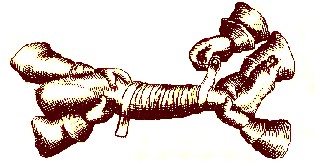
Bandaging a Leg, From L'Arcenal de
Chirurgerie
by Johannes Scultetus, p. 106 (1653)
The third step in curing fractures during the golden age of piracy is to preserve the tone of the part fractured.
We have already seen how 'bad' humors were thought to flow to fractured part and cause problems during healing. To encourage the fracture to repair itself, period surgeon believed these bad humors had to be removed or driven away, which was a goal of preserving tone. This involved healing the wound in a complex fracture so that the bad humors would not gather there, letting the patient blood, adjusting the patient's diet to encourage the generation of good humors and reduction of bad ones and administering medicines.
Preserving Tone: Treating Compound Fracture Wounds
Doing what was required to heal the wound that accompanied a compound fracture was actually one of the first things the surgeon would attempt. Wounds created swelling and pain, two things that made it difficult for the surgeon to set a fracture.
Removing Foreign Objects From the Wound
To begin, foreign particles needed to be removed from the wound. Sea surgeon John Atkins explained that it was "our first and immediate Care, and is by no Means to be deferred, lest the Tumor and Stiffness of the Part prove afterwards an insuperable Difficulty"1.
In one case, when he suspected there were foreign particles in the wound, Richard Wiseman
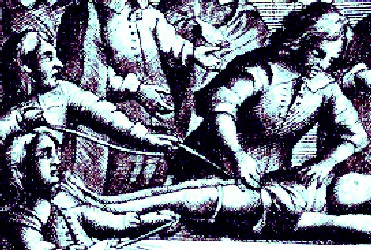
Wound Examination, From L'Arcenal de
Chirurgerie
by Johannes Scultetus, frontispiece (1653)
simply put his "Fingers into his Wound" and "pulled out first a piece of Splinter an inch thick and thereabouts, more or less; then Rag and Bones, great and small; I left not the least Shiver [fragment of bone]."2
Atkins also suggested reaching in to search for and remove foreign objects, although he advises using "our Feeling [fingers], and Instruments together"3. Atkins adds an interesting point with regard to using tools. "In extracting these Bodies the Forceps should not be opened until you touch them, lest you inclose some Flesh or Tendon; that will both frustrate the Removal, and give unnecessary Pain."4
When a fracture is comminuted [the bone has been smashed into pieces] and there is a lot of material to be removed from it, Atkins says that "a large Wound is safer and
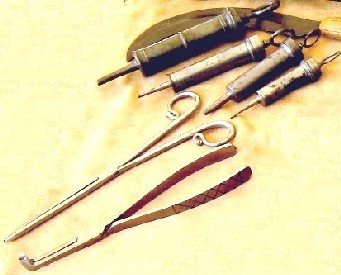
Photo: Mission
Forceps for Removing Foreign Objects, Syringes for
Injecting Decoctions from the Author's Collection
more commodious for this End, than a small; and where the Smallness is visibly, and Impediment to Extraction, as in Fractures from Musket-Shot, whose Orifices contract, there is an absolute Necessity of dilating."5 This would be performed with scalpel.
Atkins notes that when you've removed everything within your reach, "it may be proper to inject some warm Wine, or the Decoction of some vulnerary [healing] Herbs, to bring away any remaining indiscernable Ossicles [pieces of bone] or Bits of Garment."6
Of course, Atkins admits that fragments may be left behind, given the crude method for extracting them. He advises that it "is better afterwards left to the expulsive Power of Nature, which more kindly thrusts towards the Orifice [of the wound] any remaining Extraneosity, than can be effected by any dark Search with Probe or Forceps, especially in thick muscular Parts"7.
` John Atkins, The Navy Surgeon, p. 65; 2 Richard Wiseman, Of Wounds, Severall Chirurgicall Treatises, p. 428; 3 Atkins, p. 65; 4 Atkins, p. 65-6; 5 Atkins, p. 64; 6 Atkins, p. 66; 7 Atkins, p. 64
First Wound Dressing
"Also if there be a wound, you must so order the matter, that you may daily apply to the wound necessary medicines". (John Woodall, the surgions mate, p. 165)
Wound dressing is often treated in a separate section by period surgeons as wounds were a problem unto themselves and so deserved a topic unto themselves. However, a few period surgeons do discuss treating a wound accompanying a fracture.
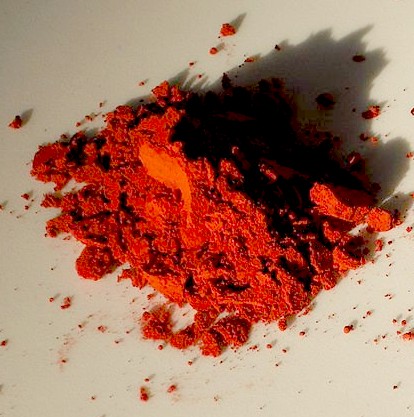
Photo: Andy Dingley -
Powdered Dragon's Blood
The first wound treatment involved medicating the wound and applying simple dressings to protect it. Sea surgeon John suggested using a styptic medicine to stop bleeding which he called a Defensiv. Magnum. He refers the reader to his prescription for Aqua Styptica (Moyle's preparation No. 3) which is made by beating oak bark in wine vinegar, allowing it to fully infuse and then adding Pulv. Thuris [powdered frankincense] and Sanguis Draconis [Dragon’s blood - a bright red crushed incense obtained from various plants].1
Moyle explains that the surgeon was to take this concoction, "spread [it] on a double bolster, and apply it round the part; only where the Wound is, contrive that the end of that defensive may be to wrap over. But before you wrap it over, dress the Wound with Tincture of Myrrh on Dorcels [pieces of soft lint] next the bone; and Digestiv. opt. over that"2 The last medicine was Digestivum Optimum (Moyle's preparation No. 6) which was used to build tissue. It contained Terebinth. [turpentine], vitell. ovi. [egg yolk], Ol. Catellorum [oil of new whelped puppies] mixed with honey, and Pulv. Croci. [powdered saffron].3
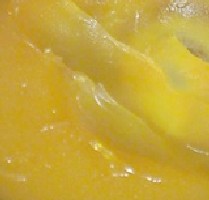
Woodall's Arceaus Linament
John Woodall says "the best locall medicine to wounds with fractures in my opinion is good Bazillicum or Arceus Linament [Unguentum Elemi or yellow basilicon - a mixture including a tree resin and turpentine] being warme applied thereto sometimes as you see cause"4.
Woodall also suggests that his reader "may use an Abstersive [cleansing] or Corroding medicine, as Allumen combustum [burnt alum]: Ægyptiacum of acids [A compound mixture containing subacetate of copper, aluminum sulphate, potassium sodium or ammonium sulfate, vinegar and sulphuric acid],
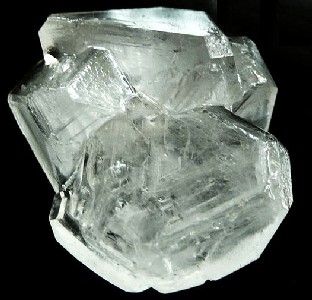
Photo: Wiki Commons User Nevit
Burnt Alum aka Potassium Alum in Crystal Form
Ung. mixtam [mixed unguents], or the like: ...but beware of the over-use of sharpe medicines often without true judgement"5. He does not explain his unusual choice of caustic medicines for a fracture. They would typically be used to remove skin that had grown where it was not wanted.
Woodall does say that complex concoctions may not be the best method of curing the wound, explaining "I have cured them often with onely a seare cloth [cerecloth - waxed cloth] made of waxe {3 ounces} rosin and sheepes suet, of each {1 ounce} dipping a course canvas therein in forme of a sparrowdrope [possibly some small drop-like shape?], and so have wrapped it warm and close about the lime [limb], that it might reach at the least three fingers above, and as much below the fracture, with apt ligature... This in fractures of the armes is as good as any, and from the first to the last this seare-cloth [cerecloth] may be used."6
Woodall notes that "in fractures with a wound, if you use unctions and liquid things, as oyles; you hazard putrifaction [decay] of the bone and apostumation [abscess]"7. Fellow sea surgeon John Atkins agrees with Woodall and recommends the "forbearing [of] any further Use of greasy Applications, for such ...foul the Bone, by increasing Corruption"8.
1 John Moyle, The Sea Chirurgeon, p. 10; 2 Moyle, p. 116-7; 3 Moyle, p. 11; 4,5 John Woodall, the surgions mate, p. 166; 6 Woodall, p. 166-7; 7 Woodall, p. 165; 8 John Atkins, The Navy Surgeon, p. 127
Bone Exfoliation
Exfoliation of a bone occurs when the bone casts off the dead parts at the ends of an exposed fracture. (It is not mentioned in conjunction with simple fractures.) Hippocrates discussed the concept of bone exfoliation in detail, noting that when it is about to occur "pus runs copiously from the sore, and appears striving to make its escape."1 Because of this,
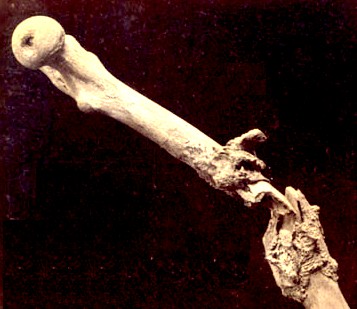
A Rather Severe Example of Bone Exfoliation with
Deposits of Spongy Callus after a Gunshot Fracture
of the
Left Femur, circa 1870, From Otis Historical
Archives of National Museum of Health & Medicine
he says that the bandages "are to be frequently renewed until the bone exfoliate, and the splints should not be applied until then."2
Two of our period surgeons recommend medicines that will hasten exfoliation of the bone. In one fracture case, surgeon Richard Wiseman says that the process of exfoliation can be speeded "by a little Ægyptiacum [a detergent ointment containing verdigris (copper acetates), honey and vinegar] and pulv. myrrhæ [powdered Myrrh] dissolved in spir. vini [brandy], applied hot upon an armed Probe."3
In his memoirs, John Moyle gives another concoction for accelerating bone exfoliation he calls an Ossific Tincture. The details of this fairly complex mixture are: "Rx. Spt. vini [brandy] {4 ounces}, Pulv. [powdered] Irios. florent [florentine iris,] aristoloch. Rotund. [Aristolochia rotunda,] Myrrh. Elect. [myrrh electuary - myrrh mixed with honey or similar substances] {2 ounces} ana. [combined with] Aloæ. Succatrin. [Aloe succotrina] {3 drams} misce. [mix] dissol. [until dissolved] ad ignem agitat. [stir rapidly] Sidet. [allow to settle] decant. servit. ad usem. [decant and use]."4
1,2 Hippocrates, Hiipocratic Writings, Translated and Edited by Francis Adams, p. 85; 3 Richard Wiseman, Of Wounds, Severall Chirurgicall Treatises, 1686, p. 485; 4 John Moyle, The Sea Chirurgeon, 1693, p. 8
Later Wound Dressings
John Moyle's also gives advice on later wound dressing, "which must be the next day; for (as I told you before) Fractures must have frequent breathing;
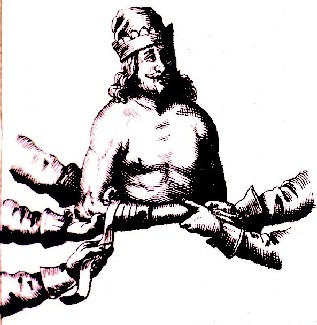
Artist: Jonas Arnold Delineavi
Dressing a Fracture for the King of Spades,
From Armamentarium
Chirurgicum
Bipartitum, by Johannes Scultetus,
p. 118 (1666)
then take off your Dressing carefully, all [the way down] to the Defensive [the bandage covering the Defensiv. Magnum - discussed in the section on First Wound Dressings] which you must leave on; only turn off the stap or end of the Defensive bolster [bandage] that is over the Wound, that you may come to dress it."1
With the defensive dressing turned aside, Moyle recommends that "the Wound be washed with Balsamick Tincture, or Tincture of Myrrh, warm"2. Richard Wiseman gives a similar prescription while treating a patient's wound in a complex fracture. He advises opening the dressing on the third day. When found to be healing well, he removed all of the old dressings "and fomented the member with warm Water, to give a breathing to it"3.
Moyle goes on to suggest that pieces of lint be covered in Balsamum Catagmos, applied warm. The prescription for for this resin is "Rx Tereb. ven. [Venice turpentine] {8 ounces}, Gum. Elemi [gum resin] {3 ounces}, Razain [raisin] {1 ounce}, vitell. Ov. [egg yolk] Pulv. Aristoloch. rotund. [powdered aristolochia rotunda] {half dram} Mastic. Olib.
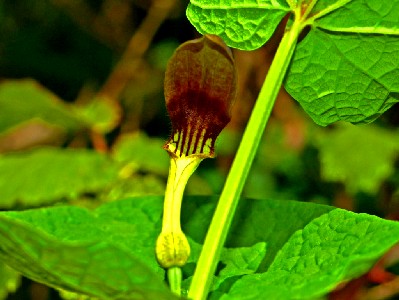
Photo: Wiki User Hectonichus
Flower of Aristolochia Rotunda (aka Smearwort)
[Frankincense resin] Myrrh, Sang. Drac. [Dragon’s blood] Croci Angliæ [saffron grown in East Anglia], ana [mix a] {half dram}, misce f. Balsam. [made into a balsam]. [This is Moyle's preparation No. 10]"4. Richard Wiseman advises a similar, yet simpler medicine, explaining that he "drest the Wound with mundificat. Paracelsi [a cleansing mixture of turpentine, honey and egg yolk - named for the physician Paracelsus] or such like" medicines5.
Moyle next applies "an Emplaster of Diapalma [a plaster of palm-oil, litharge, and sulphate of zinc] on that" which involves cutting "off the part of the Defensive bolster that wrapped over, and apply[ing] a double bolster in place of it"6. Wiseman likewise recommends "a Catagmatick Emplaster [a plaster for treating fractures - medicated with things such as Armenian bole, gum tragacanth]"7. The purpose of this plaster is to absorb pus and other things coming from the wound.
Moyle then bandages the wound again using roller bandage, warning the surgeon to "be sure it lyes as high as before, and be sure it lyes as high as the Body, that humours may not descend to the part."8 Wiseman similarly bandages the wound, although he puts "into the Wound only a Dossil or Tent [folded absorbent material used to keep a wound open] made upon [the end of] a Skewer soft and hollow, to give way to the Wound to incarn [form tissue inside the wound]"9.
For this and all future dressings,
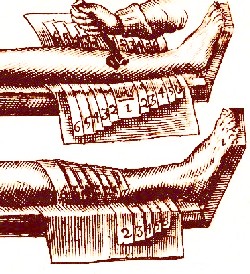
Treating a Fracture Wound and Bandaging,
From L'Arcenal de
Chirurgerie
by
Johannes Scultetus, p 74 (1653)
Moyle recommends that the surgeon "have a warm Stupe [piece of folded cloth] ready to lay on the Wound, wrung out of the Vulnerary [healing] Foment; but Stupe it not too hot
at first, least you by the heat bring down more humours to the part."10
Wiseman ends his discussion on treating a fracture wound by explaining, "I scarce using any Injection, but by gentle Compression [from the bandages] assisting Nature, who seldom faileth in supplying the lost Substance in Wounds, if we disturb her not by improper Applications."11 Note that, like the fracture, Wiseman suggests that the body will heal the wound given time. This hints that medications from the period were not very effective.
Moyle recommends continuing dressing in this manner until "there is good digestion [formation of flesh within the wound], and ill symptoms are vanished, and then let your Defensive be removed, and let Emplast. Catagmaticum mixed with Diapalma, be applyed all about the part, except just where the Wound is"12. In another case, Wiseman gives similar commentary, explaining that after two and a half weeks, the wound he was treating was "well incarned within, and the Lips beginning to cicatrize [heal by forming scar tissue] from their edges, I dressed them with Epuloticks [medicine promoting healing] as unguent. tutiæ, & c. [Tutty ointment (zinc oxide) - an astringent paste]"13
1,2 John Moyle, The Sea Chirurgeon, p. 118; 3 Richard Wiseman, Of Wounds, Severall Chirurgicall Treatises, p. 427; 4 Moyle, p. 15; 5 Wiseman, ibid.; 6 Moyle, p. 118; 7 Wiseman, ibid.; 8 Moyle, ibid.; 9 Wiseman, ibid.; 10 Moyle, p. 118-9; 11 Wiseman, ibid.; 12 Moyle, p. 119
Preserving Tone: Bloodletting
With all the concern about bad humors flowing to the site of the fracture, bloodletting would seem to be a natural
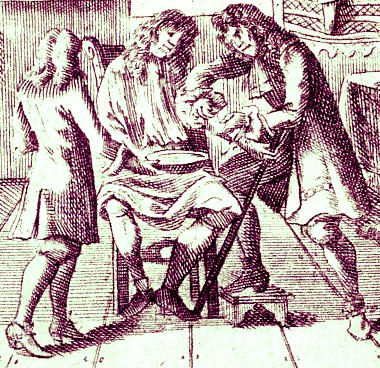
Bleeding a Patient from Georgica Curiosa Aucta
by Wolfgang Helmhard Hohberg
(1695)
part of fracture treatment for period surgeons. The appeal of letting blood was to remove or divert humors. However, there are only a few instances of it being recommended when healing fractures.
Ambroise Paré explains the concept of deflecting of humors in a fracture, including bleeding among his recommended methods for doing this. "[W]e drive away the defluxion [of fluid] ready to fall downe upon the part by medicines, repelling the humour, and strengthning the part; wee, by appointing a good diet, hinder the begetting of excrements [unwanted matter] in the bodie, and divert them by purging and phlebotomie [bleeding]."1
Richard Wiseman also suggests bleeding when curing fractures in one case. The case involved a man whose arm had been shattered above the elbow by a splinter, Wiseman "let blood the second day."2 He also advised bloodletting when the fracture was filled "with Sanies, which the Part through its weakness can neither well assimilate nor expel, and so is like to be burthened with excrementitious Humours."3 Wiseman explains, "Phlebotomy [bloodletting] may be here of special use"4, clearly thinking of relieving the part from those bad humors.
1 Ambroise Paré, The Apologie and Treatise of Ambroise Paré, p. 170-1; 3 Richard Wiseman, Of Wounds, Severall Chirurgicall Treatises, p. 427; 3,4 Wiseman, ibid.;
Preserving Tone: Diet
Many of the period surgeons offered advice on the patient's diet while the fracture was healing, still having an eye on keeping bad humors from being formed and creating good ones.
Opinions on just what this diet should be varied widely. When considering a simple fracture, HIppocrates says,
A diet slightly restricted will be sufficient in those cases in which there was no external wound at first, or when the bone does not protrude; but one should live rather sparingly until the tenth day, as being now deprived of exercise; and tender articles of food should be used, such as moderately loosen the bowels; but one should abstain altogether from flesh and wine, and then by degrees resume a more nourishing diet.1
Hippocrates' belief in spareness of diet increases when the wound is more severe. For a compound arm fracture, "The patient is to be kept on a stricter diet, and for a longer space of time than in the former case; and we must form our judgment of it from the swelling in the hand, looking also to the strength of the patient."2 With a compound leg fracture, Hippocrates advised that "the [patient's] diet
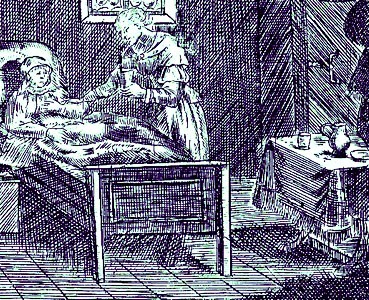
Feeding a Patient from Georgica Curiosa Aucta
by Wolfgang Helmhard Hohberg
(1695)
should be [even] more restricted ...the greater the wound [size and severity], the more severe and protracted the regimen should be."3
Richard Wiseman, who generally seems to agree with Hippocrates, advises that "a slender Diet must be prescribed" to prevent 'excrementitious humors'4. Sea surgeon John Atkins recommends the patient's "Diet to be low and such as is of light and easy Digestion, (as Gruel or Panada [a mixture of flour, water, or of breadcrumbs soaked in milk],) abstaining from Flesh; and for a common Drink, Sack-Whey [fortified wine with whey (weak milk) and sugar]"5. He also suggests some other concoctions whose primary ingredient is barley water sweetened with a various ingredients.
John Woodall's advice contradicts that of Hippocrates with a focus on the patient's environment. He says, "concerning sustenance at sea, the patient neede to have it no thinner than the Saylers ordinary"6. Fellow sea surgeon John Moyle sort of splits the difference, suggesting "This Mans Diet, although spare at first, yet when you would have the Callus to grow, and the part to strengthen, then he must have plenty of agglutinative ['sticky', by which he presumably means, building] Diet."7
Although no one suggests a hearty diet - which would usually be hard to come by on a ship in the best of circumstances, Wiseman fells compelled to argue that
for the matter [around the bone] to make Callus, most Authors do agree, that there be a greater liberty in Diet. ...this liberty in Diet I think is better forborn, for therby we often see great Obstructions arise, especially there where our Patients are inclinable to feed plentifully. Therefore in such Fractures where the Patient is constrained to keep his Bed, I propose a slender Diet, and of such things as are of easie Digestion. For without that liberty surely we cannot fail to compleat our Cure; the Bones having naturally a Poriness [porousness] in them, in which is always contained a matter fit for their Nourishment8.
Wiseman has a good point, given that the bones will heal of their own accord. No doubt a balanced, healthy diet would be most amenable to this process, but these concepts were not widely recognized at this time in history.
1 Hippocrates, Hiipocratic Writings, Translated and Edited by Francis Adams, p. 77; 2 Hippocrates, p. 78; 3 Hippocrates, p. 85; 4 Richard Wiseman, Of Wounds, Severall Chirurgicall Treatises, p. 469; 5 John Atkins, The Navy Surgeon, p. 46; 6 John Woodall, the surgions mate, p. 162; 7 John Moyle, The Sea Chirurgeon, p. 120; 8 Wiseman, p. 170,

